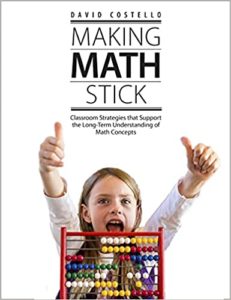Supporting Long-Term Understanding of Math
Making Math Stick: Classroom Strategies that Support the Long-Term Understanding of Math Concepts
By David Costello
(Pembroke Publishers, 2021 – Learn more)
Reviewed by Lisa Hudson
 How many times has it happened to you?
How many times has it happened to you?
You’ve taught your heart out, planned exciting math activities, worked with small groups, and prepared your students to the best of your ability to take the unit test.
They do well on the ‘unit test,’ but in a very short time your students look at you as if you are talking in a foreign language when you return to a topic that was previously taught. They tell you they have never heard that information before!
 If you have taught for any length of time, you know what I am talking about. Students frequently do not recall their previous learning, and this occurs across grade levels and schools.
If you have taught for any length of time, you know what I am talking about. Students frequently do not recall their previous learning, and this occurs across grade levels and schools.
Whatever the cause of this issue, in Making Math Stick math PD leader David Costello has given us some nuggets of advice that can help us make the shift from, as he says, “teach, test, move on” to “teach, connect, apply.”
He encourages us to take a different approach to learning for our students and gives us reason to pause and think about why the ability to recall learning has become such a problem.
In the introduction to his book, Costello provides background on the three stages of learning which include encoding, consolidation, and retrieval. He cites research for the need to make learning effortful as well as to provide multiple retrievals of knowledge to make the learning stick.
In the remainder of the book Costello offers ideas to help develop an instructional approach that emphasizes true learning as opposed to memorization.
Learning and Instructional Strategies
The book is divided into two sections: (1) learning strategies that build retention, and (2) instructional strategies that build retention. The two sections are further divided into the following chapters:
- Learning through self-assessment
- Building a network of memory
- Learning by figuring it out
- Learning by picturing it
- Learning by writing
- Using awareness strategies to improve learning
- Expanding use of formative assessment
- Focusing instruction on key concepts
- Rethinking year plans
- Rethinking testing
- Rethinking homework
- Adjusting common classroom tools and strategies
The book concludes by suggesting ways to put it all together.
Looking into the “Illusion of Mastery” and more
One area of particular interest that struck me as I read the book included the “illusion of mastery” that students feel when a topic comes easily to them so that they believe they understand it and will remember it.
Quickly completing that 20-problem worksheet on one-step equations and scoring highly on the test can be clouded over several weeks or months later when the same concept shows up in a different topic and the student who felt he had mastered it has totally forgotten he ever learned it.
How often have I, as a teacher, felt the same “illusion of mastery” for my students’ efforts as they did with their supposed mastery?
Several student learning strategies are explored throughout the first six chapters, and the author often gives an example from primary, elementary, and intermediate grade levels as to how the student can use a given strategy to improve their learning. There are several suggested prompts for each strategy as well as occasional digital solutions.
As you introduce the strategies to your students, it is important to remember that you want your students to accept that forgetting is part of the normal learning process.
Focusing on Key Concepts and Rethinking the Year’s Plans
Instructional strategies are developed in section two, and I particularly like the idea of focusing instruction on key concepts and rethinking the year’s plans. As in the first half of the book, examples of key concepts generated by a primary teacher, an elementary teacher, and an intermediate teacher are given. The key concepts idea will help you as a teacher determine which concepts to prioritize to provide the most “bang for your buck” in terms of student learning.
I am also drawn to the idea of revamping my yearly plan so that I can visit each key concept three times a year and build in more depth, layering on more knowledge with each re-visit. By my creating this spiral effect, my students will need to give more effort and dig deep to remember and apply what they have previously learned.
This book would be a nice addition to your own professional library. It details many ideas that will help you in planning the learning for your students with the goal of making a long-term change in their abilities to retrieve and truly learn the math that you teach.
I will be sharing the ideas that I have learned with fellow math teachers and encouraging them to look at their strategies to see if they truly promote long-term retention and learning.
Lisa Hudson is a 7th and 8th grade math teacher near Waco, Texas. She has served the Central Texas Council of Teachers of Mathematics as the Vice-President of Middle School and is currently the math department chair at H.G. Isbill Middle School in McGregor. Teaching middle school students is her passion.


































